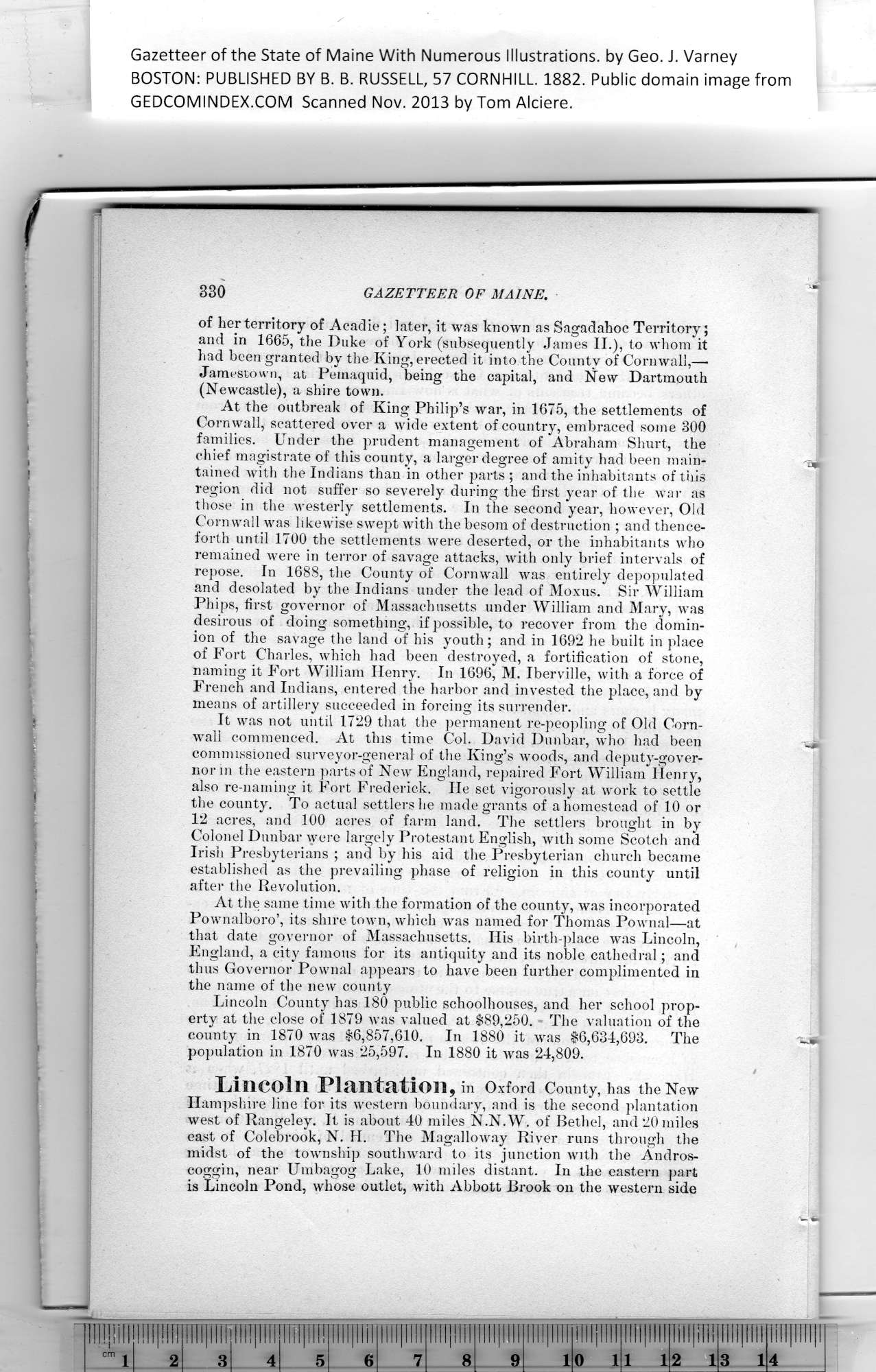|
Gazetteer of the State of Maine With Numerous Illustrations, by Geo. J. Varney
BOSTON: PUBLISHED BY B. B. RUSSELL, 57 CORNHILL. 1882. Public domain image from
830 GAZETTEER OF MAINE.
of her territory of Acadie; later, it was known as Sagadahoc Territory;
and in 1665, the Duke of York (subsequently James II.), to whom it
had been granted by the King, erected it into the County of Cornwall,—
Jamestown, at Pemaquid, being the capital, and New Dartmouth
(Newcastle), a shire town.
At the outbreak of King Philip’s war, in 1675, the settlements of
Cornwall, scattered over a wide extent of country, embraced some 300
families. Under the prudent management of Abraham Shurt, the
chief magistrate of this county, a larger degree of amity had been main-
tained with the Indians than in other parts; and the inhabitants of tills
region did not suffer so severely during the first year of the war as
those in the westerly settlements. In the second year, however, Old
Cornwall was likewise swept with the besom of destruction ; and thence-
forth until 1700 the settlements were deserted, or the inhabitants who
remained were in terror of savage attacks, with only brief intervals of
repose. In 168S, the County of Cornwall was entirely depopulated
and desolated by the Indians under the lead of Moxus. Sir William
Phips, first governor of Massachusetts under William and Mary, was
desirous of doing something, if possible, to recover from the domin-
ion of the savage the land of his youth; and in 1692 he built in place
of Fort Charles, which had been destroyed, a fortification of stone,
naming it Fort William Henry. In 1696, M. Iberville, with a force of
French and Indians, entered the harbor and invested the place, and by
means of artillery succeeded in forcing its surrender.
It was not until 1729 that the permanent re-peopling of Old Corn-
wall commenced. At this time Col. David Dunbar, who had been
commissioned surveyor-general of the King’s woods, and deputy-gover-
norin the eastern parts of New England, repaired Fort William Henry,
also re-naming it Fort Frederick. He set vigorously at work to settle
the county. To actual settlers he made grants of a homestead of 10 or
12 acres, and 100 acres of farm land. The settlers brought in by
Colonel Dunbar were largely Protestant English, with some Scotch and
Irish Presbyterians ; and by his aid the Presbyterian church became
established as the prevailing phase of religion in this county until
after the Revolution.
At the same time with the formation of the county, was incorporated
Pownalboro’, its shire town, which was named for Thomas Pownal—at
that date governor of Massachusetts. His birth-place was Lincoln,
England, a city famous for its antiquity and its noble cathedral; and
thus Governor Pownal appears to have been further complimented in
the name of the new county
Lincoln County has 180 public schoolhouses, and her school prop-
erty at the close of 1879 was valued at $89,250. The valuation of the
county in 1870 was $6,857,610. In 1880 it was $6,634,693. The
population in 1870 w'as 25,597. In 1880 it was 24,809.
Lincoln Plantation, in Oxford County, has the New
Hampshire line for its western boundary, and is the second plantation
west of Rangeley. It is about 40 miles N.N.W. of Bethel, and 20 miles
east of Colebrook, N. H. The Magalloway River runs through the
midst of the township southward to its junction with the Andros-
coggin, near Umbagog Lake, 10 miles distant. In the eastern part
is Lincoln Pond, whose outlet, with Abbott Brook on the western side
PREVIOUS PAGE ... NEXT PAGE
This page was written in HTML using a program written in Python 3.2
|
